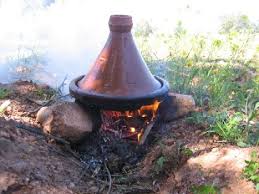
Houda Elgrich tells us about tagines in Taroudant.
In Taroudant, we have a lot of traditional dishes that represent our special culture. In this small topic, I am going to write about tagine and how people ,women in paticular, prepare it. The word « tagine » comes from a dish used in the kitchen. It is made out of clay that we put at the bakers untill it becomes baked and fit to be used in cooking. It is impossible to find a Moroccan house with no tagine because it is part of our culture. We use it to prepare different meals. A tagine contains some meat with vegetables like tomatoes, potatoes, onions, and many others. It is so delicious and healthy especially when it doesn’t contain a lot of oil. A good tagine is cooked with olive oil. In Taroudant, when people invite guests, they are very proud to serve them tagine with meat and different vegetables. It is, also, cooked on a very slow fire. Which makes of it a very delicious tagine that tastes good.

When you visit our city Taroudant, you are kindly invited to taste our tagines.
The glazed tagines sold in the west are really only suitable for using in an oven and it you approach a trader in the market about one of the fancy tagines made for tourists they will tell you they are suitable for cooking but backtrack rapidly when they realise you mean on a hob and live down the road and may return. It is the earthernware tagines that make the genuine article and whilst these can be used in an oven or on a gas hob with a diffuser the traditional method is to use a majmar,the second part of the tagine outfit ,with charcoal.
Because these have live coals people tend to put them outside on their courtyards or roofs and coming up to lunchtime after midday prayers the smells coming from neighbours can drive you to a frenzy of hunger.
In europe one tends to serve tagine with rice or if trying to be "authentic" with couscous, but in Morocco it is eaten only with bread, either the ordinary flatbread or tafoulet a speciality bread. The dish is served communally and only the right hand is used for eating.
Some of the most readily available authentic tagines can be had at motorway or roadside services where they are bought by weight.


No comments:
Post a Comment